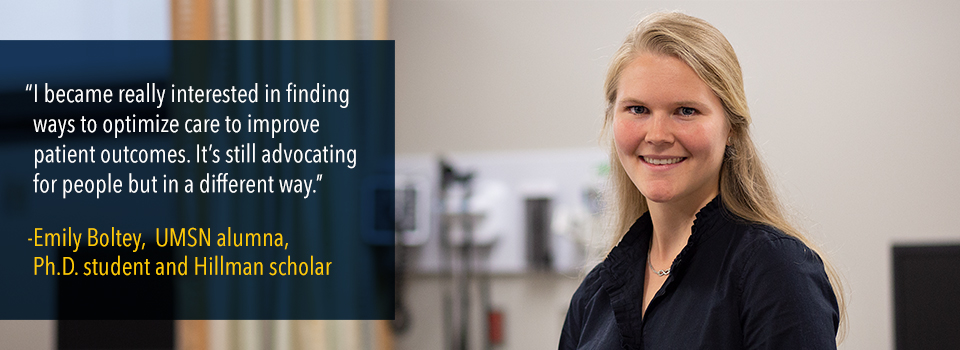Student spotlight: First Ph.D. in family of nurses

Some people become a nurse because of a personal experience. Others may do so because they were inspired by a nurse in the family. Both reasons shaped Emily Boltey’s decision.
“My grandmother had a poor health trajectory in her last few years,” said Boltey, a Pittsburgh native who comes from a self-described ‘family of nurses.’ “She was in and out of the hospital constantly. My mom is a nurse and was always my grandma’s advocate. I had that moment where I realized I want to do that for my family and for patients who don’t have a nurse in their family.”
Expanding goals
 Boltey was interested in research but wasn’t sure if it was the right fit for her advocacy goals until her sophomore year at the University of Michigan School of Nursing (UMSN).
Boltey was interested in research but wasn’t sure if it was the right fit for her advocacy goals until her sophomore year at the University of Michigan School of Nursing (UMSN).
“I thought of research as working with petri dishes in a lab,” she explained. “But, when I learned about health services research, I became really interested in finding ways to optimize care to improve patient outcomes. It’s still advocating for people but in a different way.”
Boltey was accepted to UMSN’s prestigious Hillman Scholars in Nursing Innovation program which puts talented undergraduate students on a fast-track to their Ph.D.
“A professor said, ‘When you’re a nursing Ph.D., your job is to generate knowledge,’” she said. “I remember thinking, ‘I want to do that.’ I want to help move nursing forward and generate knowledge. It’s intimidating but really exciting.”
Measuring interprofessional teamwork
How members of different professions, like nurses, physicians, and pharmacists, work together is known as interprofessional teamwork. It’s an area of growing interest to the health care community and that’s what Boltey, who earned her BSN in 2016, is focusing on for her Ph.D. dissertation.
“It intuitively makes sense that if people work better together it will improve care, but it’s a hard concept to measure,” explained Boltey. “There are so many confounding variables that it’s difficult to find a direct effect from collaboration to an outcome.”
Test case: Collaboration in the ICU
 UMSN Assistant Professor Deena Kelly Costa, Ph.D., RN, is Boltey’s mentor. Together, they are examining teamwork related to extubating mechanically-ventilated patients in a Michigan Medicine intensive care unit (ICU). The timing of the decision is critical as there are life-threatening risks for performing the removal too early or not soon enough. In addition, a mistake during the process can have severe repercussions for the patient, including death.
UMSN Assistant Professor Deena Kelly Costa, Ph.D., RN, is Boltey’s mentor. Together, they are examining teamwork related to extubating mechanically-ventilated patients in a Michigan Medicine intensive care unit (ICU). The timing of the decision is critical as there are life-threatening risks for performing the removal too early or not soon enough. In addition, a mistake during the process can have severe repercussions for the patient, including death.
“It’s a good case to use because the decision to extubate requires close collaboration between the bedside nurse, the physician and respiratory therapist,” said Boltey.
Partnering with engineers
Boltey is not just investigating interprofessional behaviors, she’s using them by teaming up with U-M’s Center for Healthcare Engineering and Patient Safety (CHEPS). She’s modifying a common engineering process to use in her dissertation and she’s working with engineering students to design an app to gather her data.
“I’m testing the use of time-motion methods,” she said. “They are most often used to evaluate industrial processes. Basically, it’s breaking down any process into individual tasks. Engineers typically use the methods to see how long it takes a worker to complete tasks and processes. I’m morphing it into health care to see if that is a way we can measure collaboration and then its impact on patient, clinician and system outcomes.”
Beyond the project
Boltey is hoping that her area of research will play a role in improving how interprofessional collaboration is viewed.
“People have a misconception that it means everyone is playing the same role,” she explained. “It’s not that. It’s the recognition that everyone has a unique contribution.”
While Boltey is quick to say that nurses don’t want to take over physicians’ duties, she does point to reasons for nurses to be natural leaders.
“The nurse is often the hub of the team and is coordinating different people and parts of care,” she explained. “Nursing is the biggest group of health professionals and we are trusted by the patients so we are in the perfect position to lead interprofessional efforts.”
Awards

Boltey’s work has already earned recognition in the research community. She received an American Thoracic Society abstract award at the organization’s 2018 conference and first place in the Ph.D. student poster category at UMSN’s 2018 Research Day.
“Interprofessional research can be frustrating,” she said. “But, it is important, so it’s really nice to get that support.”
Moving forward
In the future, Boltey is considering taking what she learns in the ICU to a population close to her heart.
“Personally, I love geriatrics,” she said with a smile. “That’s the population I gravitate towards. People in the ICU have complex issues and you can make the same argument for geriatric populations. They generally have chronic conditions and complex psycho-social needs, so there’s also a lot of interprofessional collaboration.”
Boltey says she’s grateful for the community of nurses at Michigan and in her own family who have supported her journey.
“My mom has been instrumental in my nursing career,” she said. “She jokes that I’m beyond her now, but I like being able to get her opinion as a practicing nurse. She’s really honest in her feedback.”
Boltey is on track to graduate in 2019. When she does, she will be the first to bring a Ph.D. into her family of nurses.





